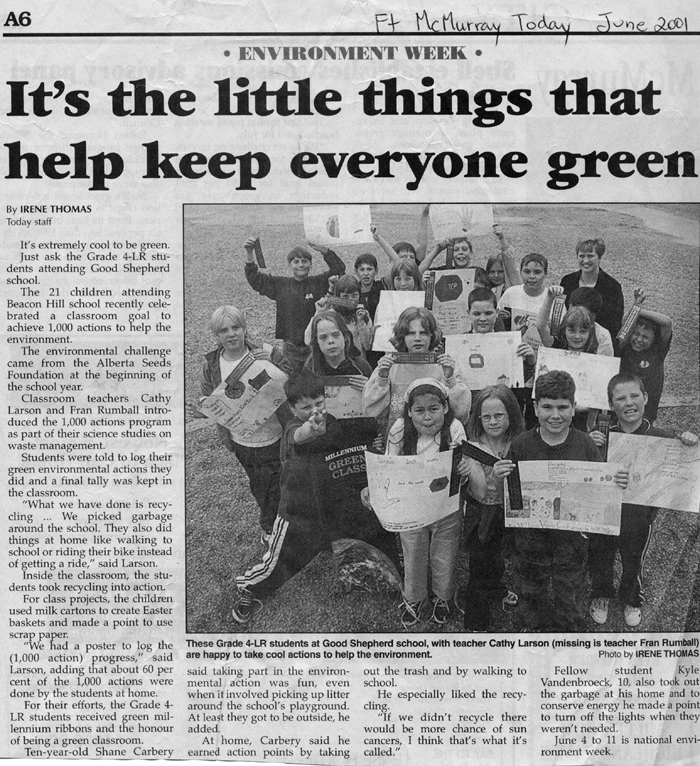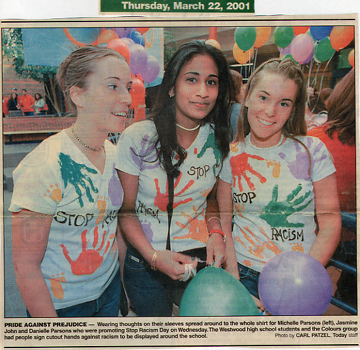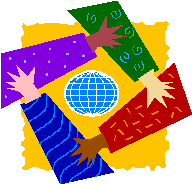 The
Global Education Club
The
Global Education Club The
Global Education Club
The
Global Education Club
Other
Great
Ft.McMurray School Projects
Students at Beaconhill Elementary School have performed over 1,000 environmental projects, including instituting daily classroom recycling, used gift sales, garbage free lunches, and school yard clean ups. They were recognized with the prestigious Wood Buffalo Environmental Award in December 2002.

Loonies For Literacy
Fort McMurray Public School District Librarians do an annual Christmas loonie
drive to buy books to help
literacy with needing children.
 Composite High School Care Kits
Composite High School Care Kits
Students of Fashion Studies at the
Composite High yearly sew bags and solicit items to donate to
our local women and children's shelter, Unity House.
"We would like to thank all those who have contributed to our donations
to Unity House. Our program has been working for many years and we are supported
by some fantastic people! We will be expanding our care kit production next
year. Please don't forget, during the summer, to collect all the shampoos,
conditioners, etc. from your travels. We gladly accept all donations of fabric,
cord, wool, sewing supplies, and toiletries necessary for the day. Any
questions, please call Pat Crossman at Composite High
School."
 The
Colours Club
The
Colours Club
from the Multicultural Association's website
The future of this great country of ours lies in the hands of our young people and when it comes to the elimination of racism, students at two of our city's high schools take that responsibility seriously.
At Westwood Community High School, students meet to find ways to increase the awareness of multiculturalism in the school. The Colors Club, as they are known, meets weekly to plan projects and activities to enhance multiculturalism and diversity in the school.
The club began with support from the Multicultural
Association of Fort McMurray and has become self-sufficient pursuing its own
mandate of supporting community organizations. About 15 students are presently members of the club.
Teacher Vicki Hunter provides support and encouragement. President Charlotte
Robertson keeps the group focused on the task at hand.

March 21 is the International Day for the Elimination of Racial Discrimination. On that day, Colors Club members handed out stickers to students and staff as a reminder that we are all different colors but still the same. The group has been supporting 3 foster children through an international charity organization but are attempting to support more local charities such as Unity House, Festival of Trees, and the United Way.
Although the school has an Anti-harassment policy, vice
principal Phil Meagher reports that most of the disagreements between students
are of a personal nature involving relationships that go awry rather than skin
color or race.
But is there any racism at Westwood? If there is, it is
not blatantly obvious. While the activities of the Colors Club might not
specifically address that issue, their activities suggest an interest and that
is a start. The issue of racism is more than
diversity. It is more than multiculturalism. It is a deep rooted problem in the
Canadian psyche that will probably only be uprooted with exposure and a
willingness on our part to admit that it does exist.
Good Shephard School
Good Shephard School students donate $325 a year to help a Kenyan girl through paying for education and nutritious food, while helping her family and community have access to clean water.
It helps the students learn about other parts of the world, and to not take things for granted.
 Students Concerned About Racism
Students Concerned About Racism
from the Multicultural Association's website:
Students at the Composite High School are doing just that. They meet every Monday. Jeff Cullihall, Mike Peters, Eric Loo, Jessica Johnson, and David Au care enough about this problem to commit time and energy to eliminating it. Is there racism out there in the halls and classrooms of our schools? We cannot be certain but if schools reflect the rest of society then the answer must be yes.
Along with teacher Ms. Kaplan, Cultural Connections, as they are called, is in the process of changing their name to SCAR, which stands for Students Concerned About Racism. Why is this a radical shift? Several reasons were given. The group senses a division among the various cultural groups within the school, as well as, a lack of understanding about the values and beliefs of others.
In the past, the members of SCAR have done many activities to promote the various cultures of the school. Christmas food from around the world was a big hit. Displaying seasons greetings from over 20 countries was part of an exhibit in the front foyer of the school.
More than just promoting multiculturalism, these club members, though few in numbers, sense an urgency and want to bring home the point that racism hurts people and is not acceptable at anytime or anywhere but especially not in their high school. In keeping with that spirit, the Racism Sucks campaign was launched. Club members handed out suckers to students to bring about impact at the conscious thought level.
In the future, they hope to look at many issues surrounding racism and create discussion through which they can influence their peers towards a greater understanding of and appreciation for others who are different. As exchange students from many countries attend Composite High School, the need for this club is even greater.
SCAR hopes to contact groups who are doing the same thing to get ideas. A World Walkway is being planned for a mural and hallway display, depicting a variety of people groups living and working together. In addition, they hope to host a film festival over noon hours during which they will show films from a variety of countries dealing with human rights and issues such as racism. SCAR raises money through bingos and food sales. As they formalize their mission and develop objectives more clearly, they hope to attract more members to help them turn hearts and change minds.
It's not just about food and culture, religion, or clothing. It is not even about tolerance and inclusion, as grand as those might seem. Can we really stop racism? Perhaps the better question might be: Can we influence people's attitudes and beliefs by providing information and experiences? These young people of Colors Club and SCAR seem to think so. Cheers to all of them!!
|
Racism
|
Westview Elementary School
|
"Bridging the Gap" is a program initiated by the Oskawasis Recreational Society as an early intervention program, funded by the Sakaw-Askiy Child and Family Services Authority. The Steering Committee consists of a representative from each of the partners, Fort McMurray First Nation #468, Beacon Hill School, Greely Road School, and Anzac School.
Amgad Rushdy, principal of Greely Road School, noted the reason for setting up the program at Greely Road was "a significant number of the school were either Metis or First Nation. It is important for the school to understand, celebrate, and nurture the heritage of their students."
Bridging the Gap has three components: To help students overcome barriers to success in school, to provide a tutorial service, and to provide transportation to allow children to participate in extracurricular activities. Some of the ways to help students overcome their barriers is to help them "stand up for themselves, but not in a violent approach," said Rushdy. He noted that no major incidents have occurred at the school because of racism. However, old stereotypes and hurtful words have caused some problems.
"The school's focus is to build self-esteem in their students, helping them understand that stereotypes come mainly from ignorance. If the student's self-worth is high enough he will think twice before getting into trouble because of someone else's actions." Mr. Rushdy also confirmed that the person with the stereotype is involved in a discussion to help him understand the impact he has on another person.
"Often the misunderstanding is out of hearsay, not based on fact. Education will hopefully diminish racism." Bridging the Gap has been successful at Greely Road School.
"We feel that we are meeting the needs of our students. The students are able to demonstrate their pride in being Aboriginal through their annual Aboriginal Awareness Days," Rushdy said. Aboriginal Awareness Days are daylong festivities at Beaconhill, Greely Road and Anzac Schools that include workshops and entertainment. All the students, from Kindergarten to Grade Eight are involved. There is also a Cree Club operating at both Greely Road and Beaconhill School. The home-school coordinator, Julia McDougall is pleased that there are also non-Aboriginal students who are very keen to learn the culture.
"The club focuses on Aboriginal crafts and ceremonies, such as the sweetgrass ceremony. They meet once a week at Greely Road school and twice a week at Beaconhill School during the lunch hour. The junior high students are able to learn the history and culture of the First Nations in this area."
McDougall's time is split between meeting with the parents, teachers, the students, and the Steering Committee. She is busy but loves her job. She helps the parent understand their children's needs. Sometimes she helps them fill out forms or brings the parents to meet with the teacher. McDougall also works with the staff in learning about the Aboriginal culture. Although the program is not curriculum based, the teachers in the schools often invite McDougall to speak in the classroom.
Dawn Lizotte from Anzac School and one of the original members of the Steering Committee explained that "those involved in working with students need to understand that there are distinct differences in the Aboriginal and Euro-Canadian culture with regards to education. One of our program goals is to change the level of social acceptance that seems to have grown up around truancy within our communities. The Steering Committee, set up in February of 1997, stated in their last report that they have seen a change in attitudes toward truancy, particularly in younger parents. Parents are becoming more involved in their child's education. Opportunities for the parents and school to meet have improved relationships with the First Nations people. Having a person of Aboriginal descent work with the parents and the staff at the schools has improved understanding."
|
The Global
Education Club
Website
E-mail contact: kathleen.cochrane@fmpsd.ab.ca Check out Kitty's other webs at www.kittycochrane.ca
|